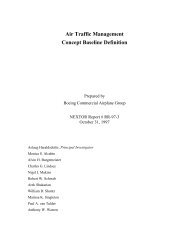Chapter 11: Weather Theory - FAA
Chapter 11: Weather Theory - FAA
Chapter 11: Weather Theory - FAA
You also want an ePaper? Increase the reach of your titles
YUMPU automatically turns print PDFs into web optimized ePapers that Google loves.
Prior to the passage of a typical cold front, cirriform ortowering cumulus clouds are present, and cumulonimbusclouds are possible. Rain showers and haze are possible dueto the rapid development of clouds. The wind from the southsouthwesthelps to replace the warm temperatures with therelative colder air. A high dew point and falling barometricpressure are indicative of imminent cold front passage.As the cold front passes, towering cumulus or cumulonimbusclouds continue to dominate the sky. Depending on theintensity of the cold front, heavy rain showers form andmight be accompanied by lightning, thunder, and/or hail.More severe cold fronts can also produce tornadoes. Duringcold front passage, the visibility is poor, with winds variableand gusty, and the temperature and dew point drop rapidly.A quickly falling barometric pressure bottoms out duringfrontal passage, then begins a gradual increase.After frontal passage, the towering cumulus and cumulonimbusclouds begin to dissipate to cumulus clouds with a correspondingdecrease in the precipitation. Good visibility eventuallyprevails with the winds from the west-northwest. Temperaturesremain cooler and the barometric pressure continues to rise.Fast-Moving Cold FrontFast-moving cold fronts are pushed by intense pressuresystems far behind the actual front. The friction betweenthe ground and the cold front retards the movement of thefront and creates a steeper frontal surface. This results in avery narrow band of weather, concentrated along the leadingedge of the front. If the warm air being overtaken by thecold front is relatively stable, overcast skies and rain mayoccur for some distance ahead of the front. If the warm airis unstable, scattered thunderstorms and rain showers mayform. A continuous line of thunderstorms, or squall line,may form along or ahead of the front. Squall lines presenta serious hazard to pilots as squall type thunderstorms areintense and move quickly. Behind a fast-moving cold front,the skies usually clear rapidly and the front leaves behindgusty, turbulent winds and colder temperatures.Flight Toward an Approaching Cold FrontLike warm fronts, not all cold fronts are the same. Examininga flight toward an approaching cold front, pilots can get abetter understanding of the type of conditions that can beencountered in flight. Figure <strong>11</strong>-27 shows a flight fromPittsburgh, Pennsylvania, toward St. Louis, Missouri.COLD AIRWARM AIRCUMULONIMBUSSt. LouisIndianapolis200 milesColumbus400 milesPittsburgh600 miles10<strong>11</strong>100846103306642100510St. Louis1005100874 071371 477 1026 875 12210733 12702535Indianapolis Columbus Pittsburgh10<strong>11</strong>1014METAR KSTL 1950Z 30018KT 10SMSCT010 08/02 A2979METAR KIND 1950Z 20024KT 3SM +TSRAOVC010 24/23 A2974METAR KCMH 1950Z 20012KT 6SM HZBKN025 25/24 A298310<strong>11</strong> 10<strong>11</strong> 1014METAR KPIT 1950Z 20012KT 3SM FUSCT035 24/22 A2989Figure <strong>11</strong>-27. Cold front cross-section with surface weather chart depiction and associated METAR.<strong>11</strong>-21
















